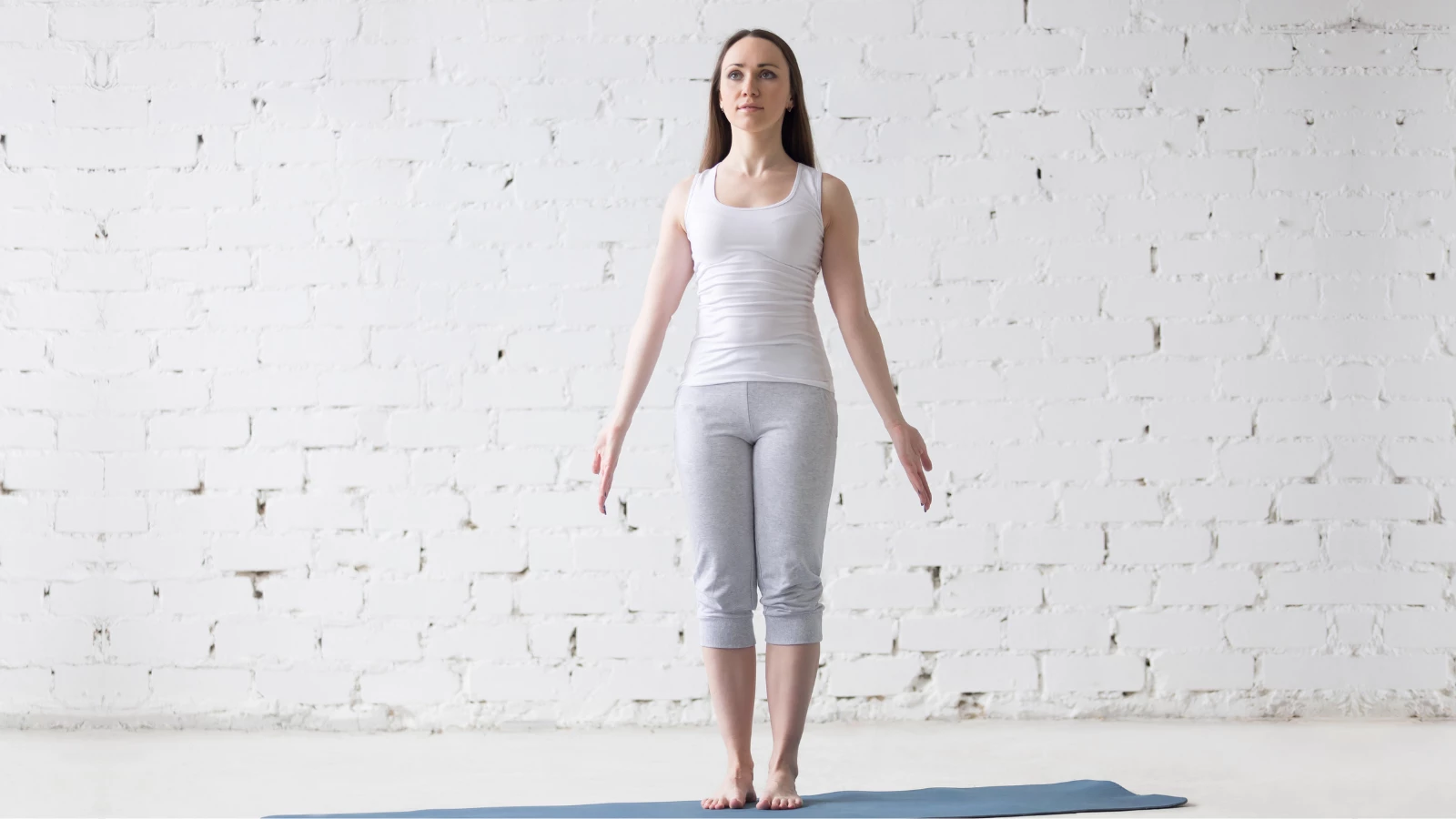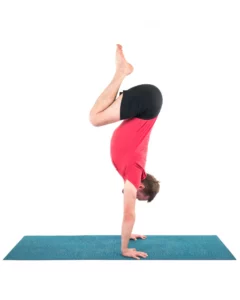Mountain Pose Focus in Yoga Practice: Lengthening Your Side Body

Article At A Glance
Mountain Pose (Tadasana) is yoga’s foundational pose. Learning healthy alignment in Tadasana teaches healthy alignment in other poses. Several Mountain Pose variations using various props highlight the diversity of this iconic yoga pose.
Years ago, I went to India to study with B.K.S. Iyengar with a group of experienced yoga practitioners from around the U.S. While many of my classmates were eager to practice complicated asanas with Mr. Iyengar, I realized early on that my trip would be a success if I took away an understanding of Mountain Pose (Tadasana). That’s because Tadasana holds the keys to the foundations of all the other asanas.
Samasthiti is another name for Mountain Pose. Sama = equal, same; Sthiti = standing, still steady. The pose mimics the qualities of a mountain—tall and stable.
Mountain Pose is More Complicated Than It Looks

For such a “simple” pose, there are lots of alignment points to consider:
- Feel your body weight evenly distributed from one foot to the other.
- Distribute your weight evenly between your two feet. Feel the weight distribution between your inner and outer feet and between the balls of your feet and your heels.
- Create arches in your feet: You can enhance your arches by lifting your toes off the floor. Then see if you can maintain your arches as you lower your toes.
- Firm your quadriceps to draw your kneecaps up.
- Draw the heads of your femur back so that your pelvis tilts forward.
- Root your feet into the floor.
- Elongate your arms.
- Lengthen the sides of your trunk.
- Move your dorsal spine into the body to lift and broaden the front of the chest.
- Roll your shoulder blades back and flatten them onto your back.
- Balance your head atop your spine, relaxing your neck.
- Learn how to distribute the weight when your arms are taken through various movements without disturbing and shaking the body.
- Learn to look at the whole body to feel its existence and nearness.
- And most important: tune into your breathing. Adjust your position so that your breathing is relaxed and easeful.
Standing Tall: Lengthening Your Side Body
When we’re practicing Mountain Pose, we often focus on how to align the anterior and posterior sides of the body. This is, of course, an important inquiry. For example, hypermobile practitioners often overextend the front body and allow the back ribcage to sag down toward the pelvis. This compresses the low back. So it’s important to think about lifting both front and back equally.
However, we often forget to invite the sides of the body into the pose. Lengthening the sides of the body helps to bring the whole body into harmony with itself. We can use a simple folding chair to familiarize ourselves with what it feels like to lengthen the sides of our bodies.
Explore Lengthening Your Side Body in Mountain Pose
Variation 1 With a Chair to Help Stand Tall
- Fold the chair and place it directly in front of your body.

- Place your hands on the sides of the chair and push down. Feel the sides of the trunk and the entire spine lengthen.
- Lift your anterior superior iliac spine (the “hip points”) toward the backrest. Lift your navel away from the chair’s backrest without tucking your tailbone.
- Draw up your kneecaps until the legs are fully extended and the kneecaps are firm.
- Make sure to distribute the work throughout the body evenly so that every part of the body is engaged in the pose.
- Check your breathing. Your abdomen should expand as you inhale, and as you exhale, it should contract. Make sure your breathing is steady and easy. If it’s not, relax a bit.
Variation 2 With a Chair to Lengthen and Broaden the Chest
 Place the folded chair directly behind your body.
Place the folded chair directly behind your body. - Press your hands into the sides of the chair to lengthen the sides of the trunk, widen the collarbones and broaden the chest.
- Roll your shoulders back and lengthen your neck by lifting your occiput (the base of your posterior skull).
- Fully extend the fronts, backs, and sides of your legs.
- Check your breathing: can you breathe easily, expanding your abdomen on the inhalation and contracting it on the exhalation? If not, relax a bit.
Mountain Pose Tutorial Video: with a Block at the Wall
Also, read...
5 Ways to Power Up Your Practice with Yoga Props
5 Creative Ways to Practice Half Moon Pose
Be Unshakeable: Find Tadasana in 3 Standing Yoga Poses
Related courses
Breath as Medicine: Yogic Breathing for Vital Aging
Yoga and Myofascial Release: Releasing Chronic Tension with the Bodymind Ballwork Method
Yoga and Detoxification: Tips for Stimulating Lymphatic Health

Charlotte Bell began practicing yoga in 1982 and began teaching in 1986. She was certified by B.K.S. Iyengar in 1989 following a trip to Pune. In 1986, she began practicing Insight Meditation with her mentors Pujari and Abhilasha Keays. Her asana classes blend mindfulness with physical movement. Charlotte writes a column for Catalyst Magazine and serves as editor for Yoga U Online. She is the author of two books: Mindful Yoga, Mindful Life, and Yoga for Meditators, both published by Rodmell Press. She also edits Hugger Mugger Yoga Products’ blog and is a founding board member for GreenTREE Yoga, a non-profit that brings yoga to underserved populations. A lifelong musician, she plays oboe and English horn in the Salt Lake Symphony and the folk sextet Red Rock Rondo whose 2010 PBS music special won two Emmys.



